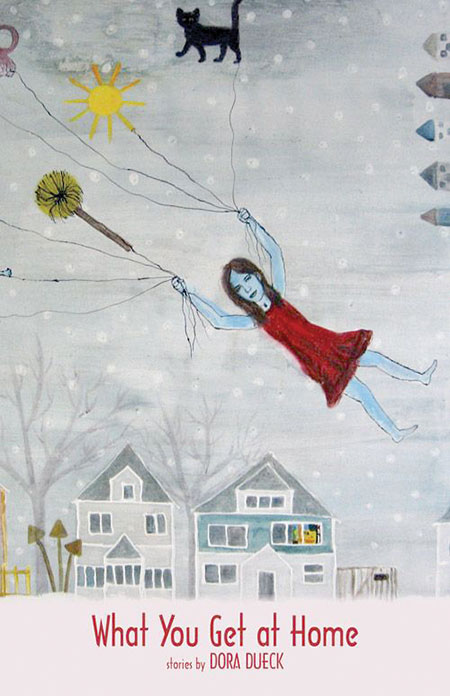by Frieda Esau Klippenstein
Winnipeg, Manitoba
|
Dora Dueck, What You Get at Home. Winnipeg: Turnstone Press, 2012, 179 pages. ISBN 978-0-88801-404-7, $19.00 (paperback)
 What You Get At Home is Dora Dueck’s first collection of short fiction, which follows her two well acclaimed novels, Under the Still Standing Sun (1989) and This Hidden Thing (2010). In this latest work, most of the stories are set in the “triangle” of Winnipeg, the Russian steppes, and the Paraguayan Chaco. They explore themes of migration and sympathetically convey feelings of loss, displacement, nostalgia, and confusion over the meanings of home. This adds insight not only into the experience of many Mennonites in Canada, but illuminates the trans-national immigrant experience in general. The stories will be especially relatable for Winnipeggers, as the characters navigate such familiar places as the apartment blocks on Edison Avenue, the sands of Patricia Beach, and the stretch of Highway 75 to the border crossing at Emerson. The reader is challenged to consider whether life in the heart of Canada—with its stifling summer heat, long dark winters, and immigrant labour jobs—is necessarily an uncomplicated fulfillment of the immigrant dream.
What You Get At Home is Dora Dueck’s first collection of short fiction, which follows her two well acclaimed novels, Under the Still Standing Sun (1989) and This Hidden Thing (2010). In this latest work, most of the stories are set in the “triangle” of Winnipeg, the Russian steppes, and the Paraguayan Chaco. They explore themes of migration and sympathetically convey feelings of loss, displacement, nostalgia, and confusion over the meanings of home. This adds insight not only into the experience of many Mennonites in Canada, but illuminates the trans-national immigrant experience in general. The stories will be especially relatable for Winnipeggers, as the characters navigate such familiar places as the apartment blocks on Edison Avenue, the sands of Patricia Beach, and the stretch of Highway 75 to the border crossing at Emerson. The reader is challenged to consider whether life in the heart of Canada—with its stifling summer heat, long dark winters, and immigrant labour jobs—is necessarily an uncomplicated fulfillment of the immigrant dream.
The stories are overwhelmingly of serious subject matter and, one could say, rather heavy in atmosphere. Yet, even when its theme is sadness, regret, betrayal, longing, or disappointment, a story well written is a thing of beauty, and there is indeed much of beauty here. Dueck clearly knows these people, perhaps is some of these people. In confident, deft strokes she captures the essences of her characters and their relationships to one another, using layers of perspective to lure us to a place of empathy and new understanding.
Dora Dueck is an historian, and in these succinctly constructed stories she reminds us that personal memory and narrative are the building blocks of history. In many of the stand-alone chapters of the book, people compose their stories, correct their stories, learn their parents’ stories, and search for the truth about their stories. In “My Name is Magdalena” an elderly woman attends a writing class to learn how to record her memoirs. In “Postponement” Shelley journals and practises how she will accomplish the difficult task of revealing bad news to her husband. The story “In the Village of Women” features a grandmother struggles to convey a long-hidden chapter of her story to her granddaughter, and how she maintained her dignity in a humiliating, socially unacceptable situation.
Dueck is hinting throughout at something essential about the nature of history itself—that there are spaces in our histories, and that people’s stories, as experienced and remembered, fill these spaces. Often Dueck juxtaposes a character’s personal story with words more officially recorded, in order to demonstrate the idea that the story, as told by the ordinary people who lived it, can indeed be more powerful and “true” than the dry bones of the obituary, the archival document or the history book, which often do not come close to conveying what actually matters most. The power of story, on the other hand, is clear. It can make you laugh and cry, feel empathy and better understand. In the story “Helping Isaac” a man who is haunted by the repressed memories of what happened to him and his family in Siberia hires a researcher. The researcher finds the cryptic document that can perhaps answer the man’s questions, but it is her creative, gentle storytelling that puts his mind at ease.
In the title story, “What You Get At Home” Lise is forlornly homesick and finds inspiration, relief, and joy in an Anne Taylor novel which she hunts down because it has the word “homesick” in the title. She devours the book in one sitting through the night, and in the process it hauls up startling memories that she hadn’t considered in years. She uses poignant words to describe this joy of literary discovery, and remarks on “the good work a book can do” (p. 159). In similar ways, Dueck’s book does the good work of helping readers to understand and to relate.
We thank Clara Bachmann for assistance in preparing the online version of this article.
Page revised: 3 April 2020